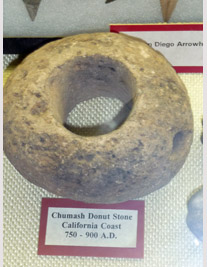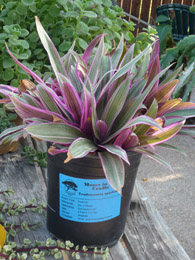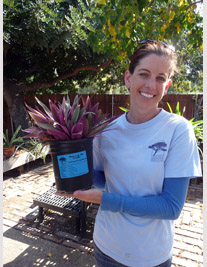By Donald H. Harrison
 EL CAJON, California — As I paused in front of an exhibit case at the Heritage of the Americas Museum on the campus of Cuyamaca College in the Rancho San Diego area, I couldn’t help but think of the late publisher of the California Jewish Heritage newspapers Herb Brin.
EL CAJON, California — As I paused in front of an exhibit case at the Heritage of the Americas Museum on the campus of Cuyamaca College in the Rancho San Diego area, I couldn’t help but think of the late publisher of the California Jewish Heritage newspapers Herb Brin.
 Inside the exhibit case was a round stone, with a hole in it, labeled as a Chumash donut stone
Inside the exhibit case was a round stone, with a hole in it, labeled as a Chumash donut stone
I remembered the delight that Brin, poet and publisher, took in learning that the Native Americans who lived in the San Fernando Valley and north from neighboring Ventura County were named the Chumash Indians. True, they pronounced their name “Chew-mash,” but in Herb’s fertile imagination the name was pronounced “Hoo-mash.” With that Hebrew pronunciation, “Chumash” means the five books of the Torah, with their chapters typically divided into the parashot of the week.
Brin was so excited by the similarity in names that at the Native-American-oriented Chumash Interpretive Center in Thousand Oaks, he once persuaded all or most of the local rabbis to pose together by the Chumash sign.
However, Brin, the social justice champion, did not simply superimpose Jewish culture upon the culture of Native Americans. When Russell Means, an Ogala Sioux, campaigned for American Indians rights with demonstrations and occupations of various American landmarks including Alcatraz, the Mayflower replica, and Mount Rushmore, Brin was among those who sympathized editorially with the Native American movement.
The Inter Tribal Council of California subsequently honored Brin with a ceremony in the Los Angeles parking lot of the Heritage offices, presenting him three painted branches in a triangle with an animal skin stretched among them. At that ceremony, the 6’1 Brin was given the name “Chief Tall Bear” and his wife, Minna, was named Flying Dove.
Standing in front of the exhibit case at the museum, I just knew what Brin’s reaction would have been to the Chumash donut. “Donut, hell! That’s a bagel—a Chumash bagel stone!”
The museum was a stop on a walking tour that Dan Schaffer and I took of Cuyamaca College, which can be reached by people living closer to the coast by taking State Highway 94 to its end and continuing on the surface street (it changes names from Campo Road to Jamacha Road) until the traffic signal at Cuyamaca College Drive West. Turn left onto the campus and the museum very quickly is reached on the right side of the road.
Besides by the Chumash bagel—er, donut—I was fascinated by a display of a set of illustrations by R. Padre Johnson, depicting the many racial and facial types of our human family. One large sized illustration depicted the entire earth (as seen from space) surrounded by people in various types of costume. Smaller illustrations broke the Earth down by geographic regions, including “the Arab World and Israel.” The Israeli Jew in the image looked like someone I knew.
After being guided around the museum by director Kathleen Oatsvall, Dan and I walked to the nearby Water Conservation Garden in which techniques for using less water for gardens and lawns in urban settings are demonstrated in pleasant surroundings. When I saw some plastic piping for drip irrigation, I remembered that it was an Israeli, Simcha Blass, who perfected the technique of drip irrigation and created Netafim, a worldwide company that specializes in low-use water solutions.
Since then Israeli companies have pioneered numerous innovations in agricultural technology. I couldn’t help but think that the water conservation garden would be a good place for Israel to show the many ways its companies have helped the world preserve its precious resources.
 On Dan and I walked across a campus road to a large nursery where students learn to become horticulturalists, gardeners, landscapers, flower growers. While examining a display of various plant specimens, my eye was immediately drawn to a plant with swword-like green leaves surrounding similar leaves that were purple in color.
On Dan and I walked across a campus road to a large nursery where students learn to become horticulturalists, gardeners, landscapers, flower growers. While examining a display of various plant specimens, my eye was immediately drawn to a plant with swword-like green leaves surrounding similar leaves that were purple in color.
The name was “Moses in a Cradle,” known to scientists as Tradescantia spathacea, a perennial plant that, according to a label on the pot, will grow to 2 feet in height and 1 foot wide in sun or shade. It produces white flowers when it blooms.
I walked around the back of the Moses, and to my surprise there was a Walmart tag attached to the pot, which described the plant not as “Moses in the Cradle” but rather as an “Oyster Plant,” with the scientific name Rhoeo spathacea.
Well, now, which is it? I wondered. Was the plant named for our great teacher, chosen by God to lead our people out of Egypt? Or was it named for a sea critter that Moses learned is traif, not kosher, definitely not something to eat.
I could see the analogy between a baby in a cradle and a pearl in an oyster shell. But, really now, the idea of a plant being named simultaneously after the great Moses and a non-kosher animal—well, I needed to know which it really was.
 Suzi Agosta, lead grower in the ornamental horticulture department of the student-run nursery, told me that the plant definitely was a Moses in the Cradle. “We know that because our bible is the Sunset Western Garden Book and in addition to that we use a lot of resources on line,” she said.
Suzi Agosta, lead grower in the ornamental horticulture department of the student-run nursery, told me that the plant definitely was a Moses in the Cradle. “We know that because our bible is the Sunset Western Garden Book and in addition to that we use a lot of resources on line,” she said.
If one looks on line, one can find that both Rhoeo spathacea and Tradescantia spathacea are referred to as “Moses in the Cradle.”
“Common names are not good to use,” said Agosta, who also is a teaching assistant for Cuyamaca College’s trees and shrub course. “Common names can be applied to any number of plants and most plants have several common names.”
Although Rhoeo and Tradascentia are similar enough spathaceas to be called “Moses in the Cradle” in the common vernacular, only one of them—the one in front of us—could be identified as Tradescantia sparthacea.
So next time you call a nursery, instead of saying, “Give me a Moses in a Cradle,” you might want to be more specific. “Do you have any Tradescantia sparthacea, please?”
Dan and I had walked only a tiny segment of the sprawling Cuyamaca College. But after our exposure to Chumash donuts, water conservation techniques, and learning the analogy between the Baby Moses and an oyster, we already felt greatly enriched by our latest college experience!
*
Harrison, whose slogan is “There’s a Jewish story everywhere,” is editor of San Diego Jewish World